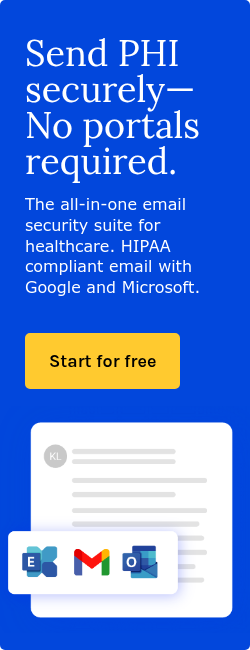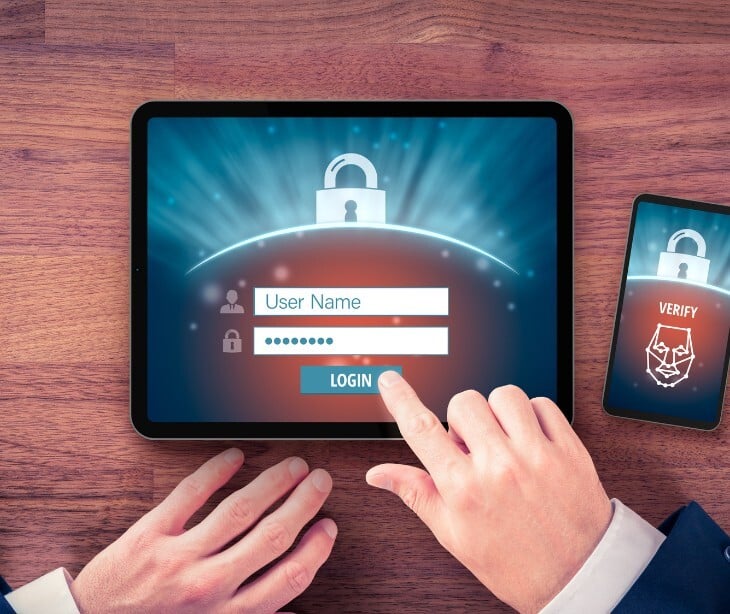5 min read
Benefits of using HIPAA compliant email to educate patients
Tshedimoso Makhene
April 09, 2025

According to Statista, in 2023, the number of global e-mail users amounted to 4.37 billion and is set to grow to 4.89 billion users in 2027. Author Laura Ceci from Statista adds, “In 2023, approximately 347 billion e-mails were sent and received every day worldwide. This figure is projected to increase to over 408 billion daily e-mails in 2027.”
These statistics demonstrate the growing reliance on email as a primary mode of digital communication. With billions of users and an increasing volume of daily emails, email remains a critical tool for both personal and professional interactions. As more healthcare providers embrace digital communication, email has become a key channel for sharing important information, such as patient education materials.
What is HIPAA compliant email?
HIPAA compliant email refers to electronic communication methods that adhere to the standards set by the Health Insurance Portability and Accountability Act (HIPAA) to protect the privacy and security of patients' protected health information (PHI). According to the U.S. Department of Health and Human Services (HHS), "The Privacy Rule allows covered health care providers to communicate electronically, such as through e-mail, with their patients, provided they apply reasonable safeguards when doing so." These safeguards may include verifying email addresses before sending messages and considering encryption to prevent unauthorized access.
Benefits of using HIPAA compliant email for patient education
Using HIPAA compliant email to send patient education materials offers several advantages for both healthcare providers and patients. It enhances accessibility, improves patient understanding, and fosters better communication between providers and their patients. Below are some of the key benefits:
Convenience and accessibility
A study by Willemse JJ and Bozalek V titled Exploration of the affordances of mobile devices in integrating theory and clinical practice in an undergraduate nursing programme, said that email can offer its users “readability, viewability, writability, accessibility, browsability, linkability and shareability.” Furthermore, participants in the study noted that they preferred using email as a communication method: “Participants confirmed that email should be the preferred communication application, since it was used by many and could accommodate larger documents.”
Email allows patients to receive important health information directly to their inbox, where they can access it anytime, from any device.
Unlike printed handouts that may be misplaced, emails provide a permanent record that can be retrieved when needed.
Enhancing patient engagement
Patients who are actively engaged in their healthcare are more likely to adhere to treatment plans and make informed decisions. For instance, research titled The challenge of patient adherence, published in the Journal of Therapeutics and Clinical Risk Management, indicates that “to improve the quality of healthcare, patients must adhere to treatment recommendations. In addition to a threat to health and the effectiveness of treatment, patient noncompliance can also have a significant economic burden. Misunderstanding, forgetting, or ignoring care recommendations can put more than 40% of patients at significant risk. Engaging between physician and patient when choosing a treatment option can maximize patient commitment and adherence. This interaction reduces the risks of noncompliance by increasing patient satisfaction and improving health outcomes." Thus, receiving educational content through email can encourage patients to take control of their health by providing them accurate, easy-to-understand information.
Read also: The link between patient engagement and health outcomes
Cost-effective and scalable
Compared to traditional methods like mailing printed materials or in-person consultations, email is a cost-effective way to distribute patient education. It eliminates printing and postage costs while allowing providers to reach many patients simultaneously. A study published in the BMC titled An economic analysis of email-based telemedicine: A cost minimisation study of two service models, found that implementing an email-based telemedicine service can lead to significant cost savings compared to traditional in-person consultations.
If you choose Paubox Email Suite as your preferred secure email provider, there are three pricing options available, each designed for up to five users, with an additional fee per extra user. The Standard Plan, priced at $29.00 per month, includes essential benefits such as secure email, secure calendar invites, secure contact forms, a business associate agreement, two-factor authentication, email reports, and phone support. The Plus Plan, at $59.00 per month, builds on the Standard Plan by adding name-spoofing protection, automatic quarantine for new domains, malware and virus protection, ransomware protection, and advanced spam filtering. For the most comprehensive security, the Premium Plan costs $69.00 per month and includes all Plus Plan features along with email archiving, data loss prevention, and HIPAA compliant voicemail transcription.
Reducing information overload during appointments
Patients often struggle to absorb all the information provided during a doctor’s visit, with only 49% remembering the decisions and recommendations made during the visit. By following up with an email containing key takeaways, additional resources, or answers to frequently asked questions, providers can reinforce important information and improve comprehension.
Facilitating better health outcomes
When patients receive timely, reliable information about their conditions, treatments, and preventive care, they are more likely to make informed health choices. A systematic review published in the Journal of Medical Internet Research titled Educating Patients by Providing Timely Information Using Smartphone and Tablet Apps: Systematic Review, demonstrated that delivering timely medical information to patients via smartphones or tablets improved their knowledge levels, medication adherence, satisfaction, and clinical outcomes. The study concluded that such educational interventions have a positive effect on healthcare economics and are most effective when conducted over short durations with frequent messaging.
Supporting a patient-centered approach
HIPAA compliant emails allow healthcare providers to tailor educational materials based on a patient’s diagnosis, treatment plan, or health concerns. As noted by Paubox, HIPAA compliant emails allow healthcare providers to tailor educational materials based on a patient’s diagnosis, treatment plan, or health concerns. By delivering personalized content, providers can address individual patient needs more effectively.
Go deeper: How patient-centered communication improves patient outcomes
Patient preference and behavioral insights
“Sixty-three percent of respondent[s] reported going to the Internet as the first source when seeking health information, while only 19% of respondent[s] reported their doctor was their first source,” writes a 2020 study titled Communication About Health Information Technology Use Between Patients and Providers, published in the Journal of General Internal Medicine. “When communicating with doctors electronically, 31% reported using an electronic health record messaging system, 24% used email, and 18% used text messaging.”
These statistics show the growing reliance on digital communication in healthcare. However, preferences can vary significantly across different demographic groups. According to a 2024 Statista report titled Online audience using e-mail services Q3 2024, by age and gender as published by Laura Ceci, looked at the global email usage by age and gender. Notable differences in email engagement among various age groups and between genders were observed with younger adults exhibiting higher usage rates of email services compared to older populations, and gender-based preferences might influence the choice of communication channels.
|
Age Group |
Male percentage usage (%) |
Female percentage usage (%) |
|
16-24 |
77.2 |
75.1 |
|
25-34 |
74.9 |
73.3 |
|
35-44 |
75 |
74.6 |
|
45-54 |
75.1 |
73.6 |
|
55-64 |
73.6 |
72.9 |
|
65+ |
85.1 |
84.7 |
By analyzing these demographic insights, healthcare providers can tailor their communication strategies to better align with the preferences of their patient population. For example, younger patients more accustomed to digital communication may prefer receiving patient education materials via email, while older patients might favor traditional methods or require additional support to engage with electronic communications.
Incorporating such demographic considerations ensures that patient education efforts are effective and inclusive, ultimately enhancing patient engagement and health outcomes.
Email, in particular, presents an opportunity for healthcare providers to share patient education materials in a format that patients are already comfortable with. By leveraging secure, HIPAA compliant email systems, providers can enhance patient engagement, improve health literacy, and ensure patients receive accurate and timely information about their conditions, treatments, and preventive care. As digital communication continues to evolve, healthcare organizations must adapt to these preferences by integrating secure email strategies into their patient education and outreach efforts.
Read also: HIPAA compliant email best practices
FAQS
What are examples of patient education materials that can be shared via HIPAA compliant email?
Providers can send newsletters, medication guidelines, post-visit summaries, appointment reminders, disease management tips, and preventive care recommendations securely via HIPAA compliant email.
Are there any risks associated with using email for patient education?
The main risk is the potential for unauthorized access to PHI if emails are not properly secured. However, using HIPAA compliant email solutions with encryption and access controls mitigates these risks.
Do patients need special software to receive HIPAA compliant emails?
No, patients can receive HIPAA compliant emails in their regular email inboxes. However, some emails may require a secure login or encrypted portal for viewing sensitive information. With Paubox, patients don't need to install any special software or log into a separate portal. Paubox uses encryption to automatically secure the email content, ensuring that sensitive health information is protected while still being easy for patients to access directly from their inbox.
Are there any specific laws or regulations beyond HIPAA that impact email communication in healthcare?
Yes, in addition to HIPAA, healthcare providers must comply with state privacy laws, the Health Information Technology for Economic and Clinical Health Act (HITECH Act), and the General Data Protection Regulation (GDPR).
Subscribe to Paubox Weekly
Every Friday we'll bring you the most important news from Paubox. Our aim is to make you smarter, faster.




